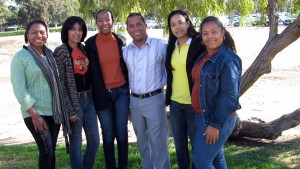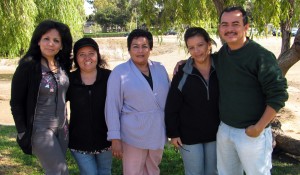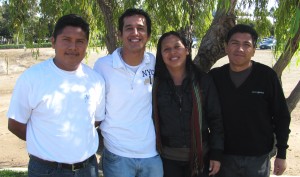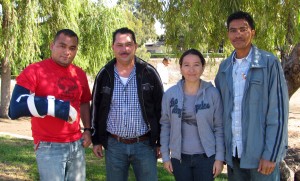This semester, elementary school teachers from rural schools in Central America and the Dominican Republic visited California State University, Dominguez Hills to learn about primary education in the United States and how to implement best practices in their schools at home. The visiting scholars were supported by the Scholarships for Education and Economic Development (SEED) program administered by the Center for Intercultural Education and Development at Georgetown University. In addition, the College of Extended & International Education (CEIE) was awarded a grant from the United States Agency for International Development (USAID), to provide instruction for the teachers by the university’s Spanish-speaking faculty as well as renowned authors. Michael Casner of CEIE’s International Training Programs was the principal investigator of the grant.

Lilia Sarmiento, associate professor of teacher education, served as curriculum coordinator and reading and writing instructor for the SEED teachers. She says that the visiting scholars provided an invaluable perspective for CSU Dominguez Hills School of Education students.
“[Hosting the SEED scholars] provided an opportunity for our teacher candidates to interact with educators from other countries to share ways of combating illiteracy and to learn together innovative and creative methods that can be carried out in any country with limited resources,” she said.
The 20 teachers, many of whom work in remote villages in El Salvador, Honduras, Guatemala, and the Dominican Republic, attended ESL classes in addition to computer literacy in English. Other topics in Spanish included critical pedagogy, early literacy, nutrition, leadership, and parental involvement. Instructors included Sarmiento, Miguel Dominguez, professor of modern languages; Margie Leon, professor of teacher education; Jose Prado, assistant professor of sociology; Yvonne Balcazar-Heinz, professor of women’s studies; Hilda Baca-Fetcenko, a lecturer in teacher education; and Rene Colato-Lainez, a children’s book author. The group also observed classroom practices in the Los Angeles, Montebello, and Lennox school districts. In addition, they shared their cultures by speaking and performing traditional dances at school assemblies and parent meetings as well as at a welcoming reception held for them at CSU Dominguez Hills.
Sarmiento says that the experience of meeting the SEED teachers was as enriching for the parents at the schools they visited as it was for the young students.
“It was a reminder for many parents of the importance of instilling a sense of pride of their family culture for their children,” says Sarmiento. “After listening to the national anthem from El Salvador, a parent with tears in her eyes went up to one of the scholars and said, ‘Thank you. It has been 20 years since I had heard our national anthem. It took me back to my childhood years.’ These are the stories that need to be shared with their children.”

The scholars also participated in “Alza Tu Voz,” a three-day summer institute in collaboration with the Montebello School District that was held at CSU Dominguez Hills. Sonia Nazario, a Pulitzer Prize-winning journalist, discussed her best-selling book, “Enrique’s Journey,” which was read during the institute. In November, the teachers attended the conference, “With Different Eyes: A Conference for Teachers of English Learners Across the Disciplines,” which was sponsored by the UCLA Writing Project, and presented a session at the conference which focused on the educational realities from each country in order to better understand students in today’s classrooms.
The SEED scholars were hand-picked by their school administrations because of their ability and commitment to their profession. María de Jesus Baldera, who teaches in a village school in the Dominican Republic, says that the experience has provided her with a wider point of view.
“It’s not [only] the teachers who are motivated to teach children, it’s the whole system,” she says. “I’m also learning from all of the other teachers from different countries. We are a resource to each other, that we are able to share what takes place on our countries, and we’ll be… much richer because of this experience of collaborating with each other.”
The teachers who were chosen as SEED scholars feel a responsibility to their students, colleagues, and communities to learn new skills and practices from American educators.
Carmen Canales says that although teachers in El Salvador have fewer resources, both countries share basic teaching strategies. However, the general point of view is that schools in the United States are superior.
Cristian Doris Rivera says that some of the main differences between schools in the Dominican Republic and in the United States are “in terms of pedagogy, the way the school is organized. The time blocks, they’re very specific. They’ve made a point about team teaching, the way teachers work together and support each other. Parental involvement is [also] one of the big differences.”

Emilia Fructuoso, who teaches in the Dominican Republic, recognized discipline and continuity as elements that she would like to implement in her teaching.
“Discipline is something that is very highly regarded here,” she notes, “How children walk in a straight line – they know exactly how to get from Point A to Point B. Another thing is the articulation between grade levels in terms of content. The kindergarten teacher has a curriculum to follow. In the same manner, the first grade teacher continues that same curriculum and continues on to first grade, second grade, and third grade. When a child moves from one school to another, the teacher knows exactly what the child has learned and where they are coming from.”
Although the teachers learned about the relative lack of resources in the United States educational system, they come from a work environment of even less. Economics and accessibility play a dramatic part in the academic progress of their students, in varying degrees. Carmon Griselda Arita shared the fact that in Honduras, most children do not go any further than a sixth-grade education because of their families’ lack of financial resources. Urbano Crisostomo says that in Guatemala, 50 percent move up past the sixth grade, with 25 to 30 percent stopping at middle school. According to Altagracia Reyes, the majority of students in the Dominican Republic graduate from high school. However, very few move up to a university education.

“Because [the people] all work in rural areas, the places where the schools are located are at a distance,” says José Manuel Saloj Aquino of Guatemala. “If they can’t pay someone to house and feed [students]… since they’re so limited, very few children continue because they don’t have the means.”
Still, the SEED scholars say that students, teachers, and parents are committed to finding ways around the limited resources. Members of the group added their daily meal allowance of $10 a day to their own funds and managed to purchase a laptop computer to bring home; a number of them had never even used one before.
“The main message here is if you desire to make a change, then you will make that happen, regardless of what the resources are that you have,” says Victor González of Honduras. “I’ve learned that it takes a village. It takes parents, it takes a community. The teachers back in our country have the desire and the heart in order to make this happen. During my time here, I really have matured and I’ve gained… the development of critical thinking that has given me various perspectives… to develop the critical thinking skills within the students back in my country. I have been able to reflect on my own personal development as a teacher… and the wealth of information that I am going to take back.”
Another SEED cohort of public health professionals from Central America participated in a similar program at CSU Dominguez Hills earlier this year and a second group focused on vector control is completing the program this semester. A third cohort of SEED scholars will begin their studies in January.
– SEED scholars’ quotes translated from Spanish by Lilia Sarmiento; feature photo courtesy of Lilia Sarmiento